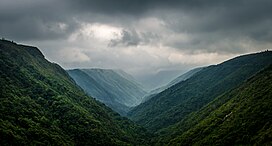| Meghalaya subtropical forests | |
|---|---|
 | |
 Ecoregion territory (in purple) | |
| Ecology | |
| Realm | Indomalayan |
| Biome | tropical and subtropical moist broadleaf forests |
| Borders | |
| Bird species | 659 |
| Mammal species | 110 |
| Geography | |
| Area | 41,700 km2 (16,100 sq mi) |
| Countries | |
| States | |
| Geology | Limestone formations (Karbi-Meghalaya plateau and westward arm of the Patkai Range) |
| Conservation | |
| Conservation status | Vulnerable |
| Protected | 1.07 (2.78)%[1] |
The Meghalaya subtropical forests is an ecoregion of Northeast India. The ecoregion covers an area of 41,700 square kilometers (16,100 sq mi), and despite its name, comprise not only the state of Meghalaya, but also parts of southern Assam, and a tiny bit of Nagaland around Dimapur and adjacent Bangladesh. It also contains many other habitats than subtropical forests, but the montane subtropical forests found in Meghalaya is an important biome, and was once much more widespread in the region, and for these reasons chosen as the most suitable name.[2][3] The scientific designation is IM0126.
The Meghalaya subtropical forests are part of the larger Indo-Burma biological hotspot with many endemic species not found anywhere else in the world. Together with the Western Ghats, Northeast India are the only two regions of India endowed with rainforest. For these and other reasons, protection and conservation of the Meghalaya subtropical forests are important on a local, national, regional and even global level.
The ecoregion is one of the most species-rich areas in India, with a rich diversity of birds, mammals, and plants in particular. The lowlands holds mostly tropical forests, while the hills and mountains, that comprise most of the area, are covered in grasslands and several distinct types of forest habitats, including subtropical moist broadleaf forests in some of the montane areas above 1,000 metres. The region is one of the wettest areas in the world, with some places, notably Mawsynram and Cherrapunji in the south of Meghalaya, receiving up to eleven meters of rain in a year.
The Brahmaputra Valley semi-evergreen forests ecoregion lies to the north, the Mizoram–Manipur–Kachin rain forests ecoregion lies to the east, and the Lower Gangetic Plains moist deciduous forests ecoregion lies to the west and south in Bangladesh.
- ^ Note: The figure in parentheses also includes reserved forest areas.
- ^ "Southern Asia: Eastern India". World Wildlife Fund (WWF). Retrieved 22 July 2019.
- ^ Note: The Meghalaya subtropical forests [IM0126] ecoregion was chosen by the World Wildlife Fund (WWF) to be almost identical to the previous biogeographical unit North-East Hills (19b) from MacKinnon (March 1997). Protected Areas Systems Review of the Indo-Malayan Realm. The Asian Bureau for Conservation Limited. ISBN 978-962-85152-1-9.